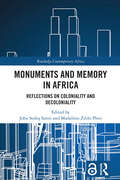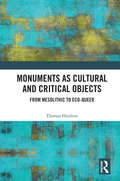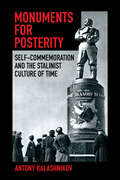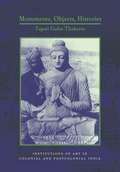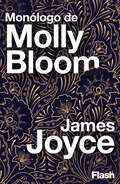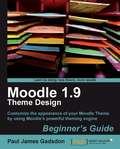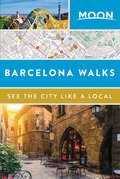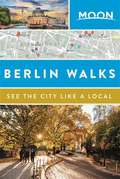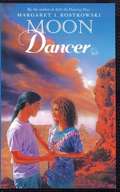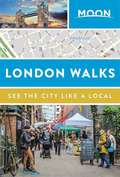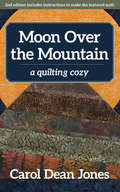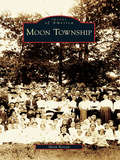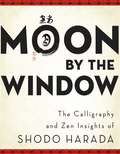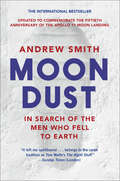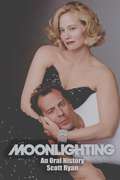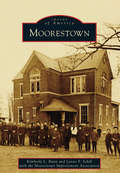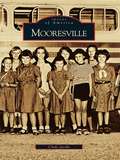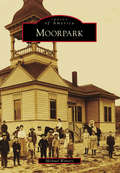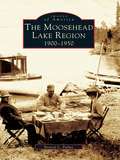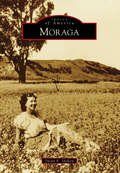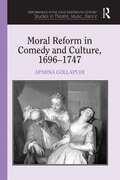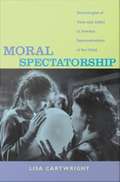- Table View
- List View
Monuments and Memory in Africa: Reflections on Coloniality and Decoloniality (Routledge Contemporary Africa)
by John Sodiq Sanni Madalitso Zililo PhiriThis book investigates how monuments have been used in Africa as tools of oppression and dominance, from the colonial period up to the present day. The book asks what the decolonisation of historical monuments and geographies might entail and how this could contribute to the creation of a post-imperial world. In recent times, African movements to overthrow the symbols and monuments of the colonial era have gathered pace as a means of renaming, reclassifying, and reimagining colonial identities and spaces. Movements such as #RhodesMustFall in South Africa have sprung up around the world, connected by a history of Black life struggles, erasures, oppression, suppression, and the depression of Black biopolitics. This book provides an important multidisciplinary intervention in the discourse on monuments and memories, asking what they are, what they have been used to represent, and ultimately what they can reveal about past and present forms of pain and oppression. Drawing on insights from philosophy, historical sociology, politics, museum, and literary studies, this book will be of interest to a range of scholars with an interest in the decolonisation of global African history.
Monuments as Cultural and Critical Objects: From Mesolithic to Eco-queer
by Thomas HoultonMonuments as Cultural and Critical Objects explores monuments as political, psychical, social and mystical objects. Incorporating autoethnography, psychoanalysis, deconstruction, postcolonialism, and queer ecology, Houlton argues for a radical, interdisciplinary approach to our monument culture. Tracing historical developments in monuments alongside contemporary movements such as Rhodes Must Fall and Black Lives Matter, Houlton provides an in-depth critique of monument sites, as well as new critical and conceptual methodologies for thinking across the field. Alongside analysis of monuments to the Holocaust, colonial figures, and LGBTQIA+ subjects, this book provides new critical engagements with the work of D.W. Winnicott, Marion Milner, Jacques Derrida, Edward Said, Eve Sedgwick, and others. Houlton traces the potential for monuments to exert great influence over our sense of self, nation, community, sexuality, and place in the world. Exploring the psychic and physical spaces these objects occupy—their aesthetics, affects, politics, and powers—this book considers how monuments can challenge our identities, beliefs, and our very notions of remembrance. The interdisciplinary nature of Monuments as Cultural and Critical Objects means that it is ideally placed to intervene across several critical fields, particularly museum and heritage studies. It will also prove invaluable to those engaged in the study of monuments, psychoanalytic object relations, decolonization, queer ecology, radical death studies, and affect theory.
Monuments for Posterity: Self-Commemoration and the Stalinist Culture of Time
by Antony KalashnikovMonuments for Posterity challenges the common assumption that Stalinist monuments were constructed with an immediate, propagandistic function, arguing instead that they were designed to memorialize the present for an imagined posterity. In this respect, even while pursuing its monument-building program with a singular ruthlessness and on an unprecedented scale, the Stalinist regime was broadly in step with transnational monument-building trends of the era and their undergirding cultural dynamics. By integrating approaches from cultural history, art criticism, and memory studies, along with previously unexplored archival material, Antony Kalashnikov examines the origin and implementation of the Stalinist monument-building program from the perspective of its goal to "immortalize the memory" of the era. He analyzes how this objective affected the design and composition of Stalinist monuments, what cultural factors prompted the sudden and powerful yearning to be remembered, and most importantly, what the culture of self-commemoration revealed about changing outlooks on the future—both in the Soviet Union and beyond its borders. Monuments for Posterity shifts the perspective from monuments' political-ideological content to the desire to be remembered and prompts a much-needed reconsideration of the supposed uniqueness of both Stalinist aesthetics and the temporal culture that they expressed. Many Stalinist monuments still stand prominently in postsocialist cityscapes and remain the subject of continual heated political controversy. Kalashnikov makes manifest monuments' intentional attempts to seduce us—the "posterity" for whom they were built.
Monuments to Faith: Ukrainian Churches in Manitoba
by Basil Rotoff Roman Yereniuk Stella HryniukUkrainians first came to Canada a century ago, seeking a new life on the western prairies. They brought with them an ancient and rich cultural tradition, deeply rooted in Christianity. The most visible symbol of this tradition is the Ukrainian church with its distinctive cupolas. As soon as the settlers were established in the new land, they began to reshape their environment by building churches in the styles they remembered from their homeland.In this richly illustrated volume, the authors trace the continuity of tradition in achitecture, art, and community life from Ukraine to the parishes of the Manitoba prairie. In a detailed examination of the exteriors and interiors of forty-nine churches, the book establishes a typology of Ukrainian church designs. Biographies of the architects, master builders, and artists are included, along with a guide to the art and architecture of a Ukrainian church.
Monuments, Objects, Histories: Institutions of Art in Colonial and Post-Colonial India (Cultures of History)
by Tapati Guha-ThakurtaArt history as it is largely practiced in Asia as well as in the West is a western invention. In India, works of art-sculptures, monuments, paintings-were first viewed under colonial rule as archaeological antiquities, later as architectural relics, and by the mid-20th century as works of art within an elaborate art-historical classification. Tied to these views were narratives in which the works figured, respectively, as sources from which to recover India's history, markers of a lost, antique civilization, and symbols of a nation's unique aesthetic, reflecting the progression from colonialism to nationalism. The nationalist canon continues to dominate the image of Indian art in India and abroad, and yet its uncritical acceptance of the discipline's western orthodoxies remains unquestioned, the original motives and means of creation unexplored. The book examines the role of art and art history from both an insider and outsider point of view, always revealing how the demands of nationalism have shaped the concept and meaning of art in India. The author shows how western custodianship of Indian "antiquities" structured a historical interpretation of art; how indigenous Bengali scholarship in the late 19th and early 20th centuries attempted to bring Indian art into the nationalist sphere; how the importance of art as a representation of national culture crystallized in the period after Independence; and how cultural and religious clashes in modern India have resulted in conflicting "histories" and interpretations of Indian art. In particular, the author uses the depiction of Hindu goddesses to elicit conflicting scenarios of condemnation and celebration, both of which have at their core the threat and lure of the female form, which has been constructed and narrativized in art history. Monuments, Objects, Histories is a critical survey of the practices of archaeology, art history, and museums in nineteenth- and twentieth-century India. The essays gathered here look at the processes of the production of lost pasts in modern India: pasts that come to be imagined around a growing corpus of monuments, archaeological relics, and art objects. They map the scholarly and institutional authority that emerged around such structures and artifacts, making of them not only the chosen objects of art and archaeology but also the prime signifiers of the nation's civilization and antiquity. The close imbrication of the "colonial" and the "national" in the making of India's archaeological and art historical pasts and their combined legacy for the postcolonial present form one of the key themes of the book. Monuments, Objects, Histories offers both an insider's and an outsider's perspective on the growth of these scholarly fields and their institutional apparatus, analyzing the ways they have constituted and recast their objects of study. The book moves from a period that saw the consolidation of western expertise and custodianship of India's "antiquities," to the projection over the twentieth century of varying regional, nativist, and national claims around the country's architectural and artistic inheritance, into a current period that has pitched these objects and fields within a highly contentious politics of nationhood. Monuments, Objects, Histories traces the framing of an official national canon of Indian art through these different periods, showing how the workings of disciplines and institutions have been tied to the pervasive authority of the nation. At the same time, it addresses the radical reconfiguration in recent times of the meaning and scope of the "national," leading to the kinds of exclusions and chauvinisms that lie at the root of the current endangerment of these disciplines and the monuments and art objects they encompass.
Monólogo de Molly Bloom
by James JoyceUn hito de la literatura inglesa moderna: el soberbio y pasional soliloquio de Molly Bloom. «[...] me gustaría que algún hombre cualquiera me cogiese alguna vez cuando él está aquí y me besase entre sus brazos no hay cosa como un beso largo y caliente que te baja por el alma casi te paraliza [...]» Cien años después de su publicación, las palabras de Molly Bloom, que cierran el gran canto épico del siglo XX que es el Ulises, siguen dejando a cualquier lector sin aliento. Sin signos de puntuación, a través del denominado «flujo de consciencia», Molly se convierte en una Penélope moderna que toma la palabra y zambulle al lector en sus pensamientos más profundos. Consciente de su complicada situación matrimonial con Leopold Bloom, tan solo le queda echar un vistazo atrás a la infancia, a sus hijos, a sus deseos más íntimos, a su radical mundanidad. Publicado por Sylvia Beach en la mítica librería parisina Shakespeare and Company en 1922, no cabe duda de que el Ulises, la obra magna de James Joyce, marcó un antes y un después en la modernidad literaria. Y no hay mejor manera de celebrar su centenario que leyendo el pasaje que encumbró al escritor irlandés. Sobre la obra y el autor:«Si tuviera que perderse todo lo que se llama literatura moderna y hubiera que salvar dos libros, esos dos libros que podríamos elegir en todo el mundo serían en primer término el Ulises y luego el Finnegans Wake, de Joyce».Jorge Luis Borges «Algo completamente nuevo. Ha logrado superar en intensidad a todos los novelistas de nuestra época.»William Butler Yeats «Ulises de Joyce es el eslabón entre los dos grandes mundos, el clásico y el del caos».George Steiner «Malditamente maravilloso».Ernest Hemingway «Había leído la novela con algo parecido a la veneración [...]. Lo leí con una dedicación queno he vuelto a tener nunca».Juan Gabriel Vásquez, El País «Un libro con el que todos estamos en deuda, y del que ninguno de nosotros puede escapar».T. S. Eliot «Cada página es maravillosa y compensa el esfuerzo».Joyce Carol Oates «Una obra de arte divina que vivirá para siempre».Vladimir Nabokov «Lo devoré en un verano con espasmos de asombro y de descubrimiento».Virginia Woolf «Navegué por primera vez en el Ulises con catorce años. Y digo navegar y no leer porque, como nos recuerda su título, el libro es como un océano; no lo lees, navegas a través de él».John Berger «Joyce está siempre en mi mente, lo llevo a todas partes conmigo. Construyó un universo a partir de un grano de arena: eso fue toda una revelación».Salman Rushdie «A veces pienso que preferiría no haberlo leído: me hace sentir inferior. Volver a mi obra tras un libro así es como si un eunuco quisiera tener voz debarítono».George Orwell
Moodle 1.9 Theme Design: Beginner's Guide
by Paul James GadsdonThis is a Beginner's Guide, with plenty of worked examples, step-by-step visual guides, and explanations. If you are a Moodle administrator, ICT technical personnel, designer or a teacher and wish to enhance your Moodle site to make it visually attractive, then this book is for you. You should be familiar with the basics of Moodle operation, and some familiarity with web design techniques, such as HTML and CSS, will be helpful.
Moon Barcelona Walks (Travel Guide)
by Moon Travel GuidesExperience Barcelona like a local: on foot! Wander "Barça's" ancient alleys and beachfront boulevards, savor the sunshine and sangria, and discover the city's hip hot spots and bohemian hangouts with Moon Barcelona Walks. This full-color guide features:Six customizable walks through the city's liveliest neighborhoods, including El Born, Gràcia, Barceloneta, the Gothic Quarter, and more, with color-coded stops and turn-by-turn directions; Foldout maps of each route and a removable full-city map in a handy, portable guide; Curated "Top Ten" lists for architecture, restaurants, Sunday activities, and nightlife, for visitors looking to hit the highlights; The top attractions and the best-kept local secrets: Browse designer boutiques and pop in to a trendy coffee shop, or stroll the beaches of Barceloneta to bask in the culture of an authentic fishing neighborhood. Marvel at the Sagrada Familia, or admire gothic architecture as you stroll the medieval streets of the historic barri. Walk through an old Olympic village, wander through Park Güell, and see the famed works of Picasso and Gaudi. Sip sangria by the beach, sample classic and modern tapas, and discover the hippest bars and clubs for a night on the town; Public transportation options, including the metro, bus, or bike rental; Tips for first-time visitors, including national holidays, where you'll need to make a reservation, and getting to and from the airport; With creative routes, public transit options, and a full-city map, you can explore Barcelona at your own pace, without missing a beat.
Moon Berlin Walks
by Moon Travel GuidesExperience Berlin like a local: on foot! Moon Berlin Walks reveals Berlin's thriving art scene, palpable history, and unique vibe by guiding you to the city's unmissable hotspots and trendiest locales. This full-color guide features: Six customizable walks through the city's hippest neighborhoods, including Kreuzberg, Prenzlauer Berg, Shöneberg, and more, with color-coded stops and turn-by-turn directions; Foldout maps of each route and a removable full-city map, in a handy, portable guide; Curated "Top Ten" lists for restaurants, street food, nightlife, and Sunday activities for visitors looking to hit the highlights; The top attractions and the best-kept local secrets: Stumble upon the newest, hippest coffee shop in Prenzlauer, or kick back in a popular public park. Discover your favorite currywurst or kebap stand, or sample schnitzel, spätzle, and brews at a biergarten. Peruse vintage knick-knacks at a Sunday flea market, and admire the works of art along the East Side Gallery. Browse world-class museums, or head to historical sites like Checkpoint Charlie. Dance the night away to an up-and-coming DJ set in an open-air club or underground warehouse party, or sip craft cocktails at a brand-new rooftop bar overlooking the city. Public transportation options, including the subway, bus, taxi, or bike rental. Tips for first-time visitors, including navigating nightlife, where you'll need to make a reservation, and getting to and from the airport. With creative routes, public transit options, and a full-city map, you can explore Berlin at your own pace, without missing a beat.
Moon Dancer
by Margaret I. RostkowskiSoon moonlight washed over everything. The houses and rocks around us and the cliff above sprang into detail in the bone white light. I hugged my knees and watched, leaning against Max, and without making a big deal about it, he put his arm around me. Then he stood up and pulled me up, too, then climbed down from the rock, signaling for me to follow. Once on the ground, he put both arms around my waist and waited until I reached up to put my arms on his shoulders. Then we began to dance, there in the moonlight, there with each other. We didn't say another word, just danced, held hands, and finally, slowly, carefully, kissed . . . then kissed again. I felt shot with silver, from the moon, from the dance, from Max.
Moon London Walks
by Moon Travel GuidesExperience London like a local: on foot! Whether you're shopping on the high street, strolling lively street markets, or admiring renowned modern art, discover London's highlights and local favorites with Moon London Walks. This full-color guide features: Six customizable walks through the city's hippest neighborhoods, including Shoreditch, Chelsea, Marylebone, and more, with color-coded stops and turn-by-turn directions; Foldout maps of each route and a removable full-city map, in a handy, portable guide; Curated "Top Ten" lists for restaurants, nightlife, markets, and Sunday activities; The top attractions and the best-kept local secrets: Head to Portobello Road Market to browse vintage treasures, or treat yourself at upscale department stores like Harrods. Make your way to the Tate Modern and other world-famous art galleries, take in London's history at Westminster Abbey, and watch the changing of the guards at Buckingham Palace. Take a leisurely stroll through Regent's Park, enjoy afternoon tea at a stylish hotel, or grab a pint and some fish and chips before heading to the theatre. Sip craft cocktails in an old train station, discover the hippest new gastropub, or watch the sun set over the city from a chic rooftop barPublic transportation options, including the underground, public buses, and taxis Practical tips for first-time visitors, including average costs, where you'll need to make a reservation, public holidays, and getting to and from the airport. With creative routes, public transit options, and a full-city map, you can explore London at your own pace, without missing a beat.
Moon Over the Mountain: A Quilting Cozy (A\quilting Cozy Ser. #6)
by Carol Dean JonesA quilting getaway in the Appalachians is overshadowed by danger in this mystery featuring bonus quilt instructions! After losing her husband, Sarah Miller has been trying to move on into a fulfilling new life, and the friends she&’s found at the Cunningham Village retirement community are a big help. And a tranquil quilting retreat in the Great Smoky Mountains will be a lovely getaway. But there&’s something alarming in the surrounding forest—and Sarah will soon have to turn her attention from threads to threats…
Moon Township
by Mark BertonAs one of the seven original townships of Allegheny County, Moon Township has a long and rich history. From the humble home of Joshua, John, and Jacob Meek in what is now Crescent Township to the Stoops House, owned by 19th-century riverboat captain William Stoops, today's Moon Township is a byproduct of these modest roots. Formed in 1788, Moon Township's history crosses borders into neighboring Findlay and Crescent Townships, which once comprised Moon. Today Moon Township is recognized as one of the most bustling and vibrant communities in the suburbs of Pittsburgh. Home to portions of Pittsburgh International Airport, a growing commercial corridor, and hundreds of new families each year, Moon Township is a major player in the future of western Pennsylvania. Through vintage photographs, Moon Township chronicles how this area has changed with the times while preserving as much of its history as possible.
Moon by the Window
by Shodo Harada Roshi Priscilla Daichi Storandt Jane Shotaku Lago Tim Jundo WilliamsShodo Harada is internationally recognized both as a Zen teacher and as a world-class master of the fine art of Zen calligraphy. Harada regularly exhibits and gives calligraphy demonstrations in museums and universities in the U.S. and abroad. Accomplished Zen teachers from across the globe come to further plumb the depths of Zen through studying with him, earning him a reputation as "the roshi's roshi" - which is to say, the master's master. Moon by the Window is a beautiful collection of 108 pieces of Shodo Harada's calligraphic Zen masterpieces - assembled over decades, and drawn from the rich and poetic literature of the Zen tradition. Each work of art is accompanied by Harada Roshi's sharp and glittering commentaries, making each page a spiritually edifying and aesthetically uplifting treasure.
Moon: Art, Science, Culture
by Robert Massey Alexandra LoskeA source of light in the dark of night and our ever-changing cosmic companion, the Moon has fascinated humankind since we first gazed into the sky. In this extensively illustrated and illuminating volume, art historian Alexandra Loske and astronomer Robert Massey present a rich and curious history. From its violent birth through to the exhilarating story of the Space Race and current exploration efforts, discover the many faces of the Moon and how they have shaped humanity's existence.
Moondust: In Search of the Men Who Fell to Earth
by Andrew SmithIn time for the 50th anniversary of the Apollo 11 moon landing comes this edition of journalist Andrew Smith’s Moondust, now updated with a new Afterword, that tells the fascinating story of twelve astronauts who ventured to space, and his interviews with nine of the surviving men.The Apollo lunar missions of the 1960s and 1970s have been called the last optimistic acts of the twentieth century. Twelve astronauts made this greatest of all journeys and were indelibly marked by it, for better or for worse. Journalist Andrew Smith tracks down the nine surviving members of this elite group to find their answers to the question "Where do you go after you've been to the Moon?"A thrilling blend of history, reportage, and memoir, Moondust rekindles the hopeful excitement of an incandescent hour in America's past when anything seemed possible as it captures the bittersweet heroism of those who risked everything to hurl themselves out of the known world—and who were never again quite able to accept its familiar bounds.
Moonlighting: An Oral History
by Scott RyanDiscover the real story behind the scenes of the 80s super-hit TV show Moonlighting, as cast and crew talk for the first time in this oral history that has &“all the delightful bounce and energy of Moonlighting,&” according to executive producer Jay Daniel."Scott Ryan Has compiled an amazing history of the show. I was there and honestly, I couldn't this down! Recommended!" - Curtis Armstrong (Herbert Voila) In the spring of 1987, over sixty million viewers tuned in to watch Maddie Hayes (Cybill Shepherd) and David Addison (Bruce Willis) &“get together&” in one of the most famously controversial scenes in television history on Moonlighting, ABC&’s groundbreaking series about an epically mismatched pair of private detectives . Two years later, the show was canceled due to low ratings. What happened? In Moonlighting: An Oral History, author Scott Ryan (The Last Days of Letterman) interviews over twenty members of the cast and creative team to get to the bottom of this perplexing mystery, uncovering hilarious, provocative, poignant, and sometimes flat-out crazy never-before-told stories about what went on behind the scenes during production of this unforgettable series. Cybill Shepherd, Allyce Beasley, Curtis Armstrong, creator Glenn Gordon Caron, producer Jay Daniel, writers, directors, editors, and more—they&’re all here, piecing together the incredible story of late scripts, backstage fights, pregnancies, and broken bones, all told for the first time. Enjoy the cases, the chases, and all the conversations in Moonlighting: An Oral History. The real story of this pioneering television series and the extraordinary behind-the-scenes challenges, battles, and rewards has never been told — until now. Author Scott Ryan (The Last Days of Letterman, thirtysomething at thirty: an oral history, The Last Decade of Cinema Massillon Against the World) interviews over twenty people, including the actors, writers, directors, and producers who made Moonlightingsuch a dynamic, unforgettable show, delving deep into their thoughts and feelings as they relive this magical moment in pop culture history in this full color oral history.
Moorestown (Images of America)
by Moorestown Improvement Association Kimberly L. Bunn Lynne F. SchillSettled in 1682 by Quakers, Moorestown grew quickly into an important agricultural and social hub. Local farms and nurseries were considered the best in the state with their superior produce and specimen plants, and the coming of the railroad in the 1860s brought industrial leaders who helped the town to grow and prosper beyond its agrarian roots. It became the home of Eldridge R. Johnson, cofounder of the Victor Talking Machine Company, and Alice Paul, a women's suffrage champion. Moorestown provided easy access to New York City and surrounding urban centers, and it continued to be a mix of sought-after residential neighborhoods, working farms, and thriving businesses. Since 1904, the Moorestown Improvement Association has been instrumental in the town's growth, with contributions including funding the first artesian well, purchasing land for the first parks and athletic fields, and registering the town in the National Register of Historic Places.
Mooresville
by Cindy JacobsIt was a hot afternoon in August 1856 when people in southern Iredell County, North Carolina, gathered for a special event. The train was on its way, bringing officials, a brass band, and the economic future. John Franklin Moore viewed the railroad tracks as an opportunity to fulfill his dream of starting a community and building a town. He knew that trains would bring customers and new citizens and carry freight to and from markets. Moore took a bold step by providing land for a depot and siding and offering land for homes and businesses. Moore's Siding prospered and grew, and in 1873, the village was incorporated and named Mooresville to honor the founder. Generations of Mooresville citizens have taken daring steps into the future, building a community that is more than just a place--it's a home. This is a story of Mooresville, the Queen of Iredell.
Moorhead
by Terry ShoptaughMoorhead, Minnesota, was founded in 1872 as a major stop on the Northern Pacific Railroad during its push toward the Pacific Ocean. The town grew to prominence in western Minnesota because of its location at the intersection of the rail line and the commercially important Red River of the North. Garnering an unenviable reputation in its early years as a wide-open town, dominated by its saloons, Moorhead subsequently developed as an important rural service center. Tracing the history of Moorhead from its founding in 1872 to the present day, the images in this volume reveal the experiences of this small Midwestern community within a framework of change and continuity.
Moorpark (Images of America)
by Michael WintersThe story of Moorpark begins with a town that was built in the right place at the right time. In the 1890s, when the Southern Pacific Railroad announced plans to relocate its Coast Line through Chatsworth to Ventura, land speculation ensued. Robert W. Poindexter, secretary of the Simi Land and Water Company, owned the plot of land that became Moorpark and laid out the townsite in 1900. A depot was quickly built, and soon, trains were arriving daily. Shortly thereafter, an application for a post office was also approved. After the completion of the Santa Susana tunnels in 1904, Moorpark began to grow. Historically, Moorpark's main source of revenue has been agriculture. Initially, dry land farming, including apricots, was preferred. As irrigation techniques improved, walnuts and citrus became the major crops. Its extensive apricot production endowed Moorpark with the title "Apricot Capital of the World." After World War II, the poultry industry became big business, with turkey, chicken, and egg ranches dotting the landscape.
Moosehead Lake Region 1900-1950, The: 1900-1950 (Images of America)
by Everett L. ParkerThe Moosehead Lake region has long been a place where travelers go to escape. In the first half of the twentieth century, the region became a mecca for hunters and fishermen, as well as for travelers looking for rest and relaxation at popular resorts such as the Mount Kineo House. The Moosehead Lake Region: 1900-1950 uses vintage photographs to tell the story of this Maine retreat. The images depict visitors and residents of Greenville, Shirley, Rockwood, Beaver Cove, and Kokadjo; the lumbering era in the North Woods; and the locomotives whose whistles pierced the wilderness.
Moraga (Images of America)
by Susan K. SkiltonLong before the Gold Rush drew settlers from the East, the land that would one day be developed into the town of Moraga was situated on a large rancho owned by the Moraga family. Nestled amongst hills just east of Oakland and Berkeley, the Moraga Valley of the 19th century attracted cattle ranchers and farmers who planted vegetables, fruit, and nuts. In particular, pear orchards established in the earliest farming days are still celebrated in the city's annual Pear & Wine Festival. In the early 20th century, tourists escaped the sometimes chilly and fog-bound cities near San Francisco Bay to picnic in the Moraga redwoods. Electric trains, which brought Moraga's commuters to cities and students to St. Mary's College, enabled the growth of subdivisions and businesses. Train tracks eventually gave way to trails for hiking, biking, and horseback riding. Once considered a potential site for the United Nations, Moraga has maintained its rural beauty while developing into a thriving suburb.
Moral Reform in Comedy and Culture, 1696-1747 (Performance In The Long Eighteenth Century: Studies In Theatre, Music, Dance Ser.)
by Aparna GollapudiIn the first half of the eighteenth century, a new comic plot formula dramatizing the moral reform of a flawed protagonist emerged on the English stage. The comic reform plot was not merely a generic turn towards morality or sentimentality, Aparna Gollapudi argues, but an important social mechanism for controlling and challenging political and economic changes. Gollapudi looks at reform comedies by dramatists such as Colley Cibber, Susanna Centlivre, Richard Steele, Charles Johnson, and Benjamin Hoadly in relation to emergent trends in finance capitalism, imperial nationalism, political factionalism, domestic ideology, and middling class-consciousness. Within the context of the cultural anxieties engendered by these developments, Gollapudi suggests, the reform comedies must be seen not as clichéd and moralistic productions but as responses to vital ideological shifts and cultural transvaluations that impose a reassuring moral schema on everyday conduct. Thoroughly researched and elegantly written, Gollapudi's study shows that reform comedies covered a range of contemporary concerns from party politics to domestic harmony and are crucial for understanding eighteenth-century literature and culture.
Moral Spectatorship: Technologies of Voice and Affect in Postwar Representations of the Child
by Lisa CartwrightWhy were theories of affect, intersubjectivity, and object relations bypassed in favor of a Lacanian linguistically oriented psychoanalysis in feminist film theory in the 1980s and 1990s? In Moral Spectatorship, Lisa Cartwright rethinks the politics of spectatorship in film studies. Returning to impasses reached in late-twentieth-century psychoanalytic film theory, she focuses attention on theories of affect and object relations seldom addressed during that period. Cartwright offers a new theory of spectatorship and the human subject that takes into account intersubjective and affective relationships and technologies facilitating human agency. Seeking to expand concepts of representation beyond the visual, she develops her theory through interpretations of two contexts in which adult caregivers help bring children to voice. She considers several social-problem melodramas about deaf and nonverbal girls and young women, including Johnny Belinda, The Miracle Worker, and Children of a Lesser God. Cartwright also analyzes the controversies surrounding facilitated communication, a technological practice in which caregivers help children with communication disorders achieve "voice" through writing facilitated by computers. This practice has inspired contempt among professionals and lay people who charge that the facilitator can manipulate the child's speech. For more than two decades, film theory has been dominated by a model of identification tacitly based on the idea of feeling what the other feels or of imagining oneself to be the other. Building on the theories of affect and identification developed by Andr Green, Melanie Klein, Donald W. Winnicott, and Silvan Tomkins, Cartwright develops a model of spectatorship that takes into account and provides a way of critically analyzing the dynamics of a different kind of identification, one that is empathetic and highly intersubjective.
